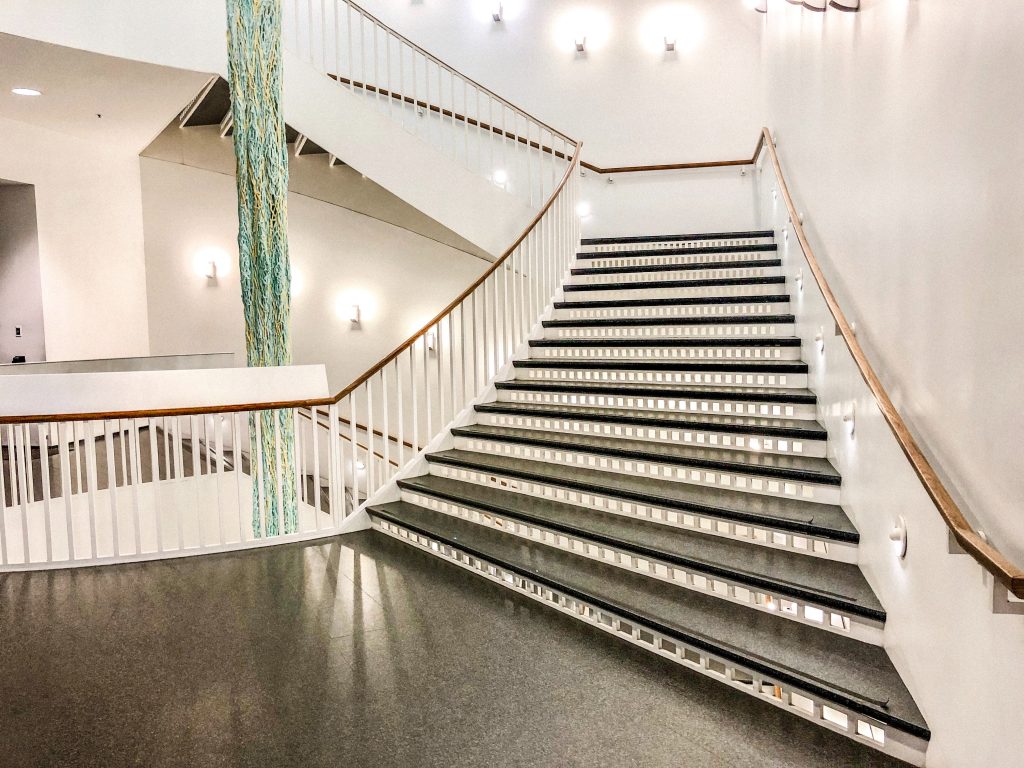Single stringer, double stringer, curved, straight…who knew that building a custom staircase could get so complicated? While designing your custom staircase isn’t quite like designing a new kitchen or bedroom, there are still many decisions to be made. What type of staircase do you like? Which kind can fit into your space? What kind of tread do you require? These questions can become overwhelming, that’s why we’ve put together a simple guide to help you build and design your custom staircase with ease.
The type of staircase
With custom staircases, there are four main types: straight, curved, spiral, and ship ladder. Each type not only differ in design, but in what particular space they’re suited to the most.
Straight stairs
Straight staircases are your most common staircase design. They run straight up to the second floor, although they can also come in L-shaped and U-shaped (also known as switchback or scissor stairs) designs. While they take up a good amount of space, you won’t need to worry about additional support structures, making them extremely easy to install. There are three types of straight stairs: single stringer, double stringer, and side stringer.
Single stringer
Single stringers have one beam or tube installed in the center capable of withstanding 300 pounds or more per tread. Straight single stringers staircases are rigid and strong, but still provide that open concept look that so many modern houses require.
Double stringer
Double stringers have two supports rather than just one. These supports, or stringers, are located under the steps. The stringers are usually set in from the edges 6” to 8” inches. These give a similar look to single stringer stairs from a side view.
Side stringer
Also known as pan stairs, side stringers have their stringers along the outer perimeter (or side) of the treads. From a side view the treads are not visible. These are industry typical designs that can be open or closed riser. They work inside for residential or commercial use, but they are also an excellent option for outdoor staircases as well.
Curved stairs
People often confuse these with spiral staircases (see below), but curved stairs are a unique type of staircase. While they have a spiral design, they do not have a center pole as spiral staircases do. As such, they must have inner handrails, although outer handrails are not always required. They often take up less space than straight staircases, and their gradation is gradual, providing an elegant and traditional appearance. Large outer diameter curved stairs can be called sweeping stairs, small outer diameter curved stairs can be called helical stairs. Helix stairs are sometimes only differentiated from spiral stairs by the lack of a center pole. Some stairs are straight at one end and curved at the other. They can also come as a single, double, or side stringer.
Spiral stairs
Spiral staircases are perhaps the oldest staircase design in the world. Far more compact than curved stairs, they’re an excellent choice for tight spaces that can’t withstand the size of a straight or curved staircase. Tiny spiral stairs have the benefit of being able to travel down face forward as opposed to ship ladders which are descended facing upwards. We define spiral stair as any staircase that radiates from central pole or support to wrap around. Spiral stairs can have a curved side stringer, or even winder shaped (straight outer lines) but most spiral stairs have treads that are independent at the outer perimeter with a circular shape. The most popular spiral stairs can be used to meet building requirements for secondary egress, but very large spiral stairs can be made to meet curved stair codes for primary egress.
Ship Ladder
A ship ladder differs quite a bit from the other staircases mentioned above. These look like your average ladder, albeit much sturdier and aesthetically pleasing. The riser height for ship ladders is normally over 9” with an angle over 60 degrees. Ship ladders are typically used as access points for lofts; this is because they take up only a minimal amount of space, especially if they come with a sliding bracket that keep your ship ladder up against the wall when it’s not needed.
The type of tread
Once you know the style of your staircase, the next thing to consider is what your staircase is going to be made out of. There are possibly hundreds of different materials to choose from, and it will all depend on what you plan to be using your staircase for and what look you prefer. Wood treads, for instance, provide a more traditional appearance and are best used indoors (although using them outside is possible depending on the wood). Steel or stone, on the other hand, are more modern and can be used inside or outside.
Here at Acadia Stairs, we provide the following materials:
Wood Treads
- Red Oak
- White Oak
- Maple
- Cherry
- Mahogany
- Walnut
- Plywood
Steel & Stainless-Steel Treads
- Smooth Plate
- Pre-Drilled Smooth Plate
- Diamond Plate
- Perforated Plate
- Textured Metal
- Sun-Burst Grating
- Grating with Diamond Plate Nose
- Diamond Plate with Grating In-set
- Pan-type Tread
- Frame-type Tread
Stone, Glass & Other Treads that we do not fabricate, but can prepare your stair to receive:
- Laminated Glass Tread
- with Diamond Pattern Top
- with anti-skid top
- Blue Stone
- Granite
- Ceramic Tile
- Pre-Cast Concrete
- Rubber
Now that you have an idea of what you’d like your custom staircase to look like, it’s time to make your dream a reality. Contact Acadia Stairs today to get started!


